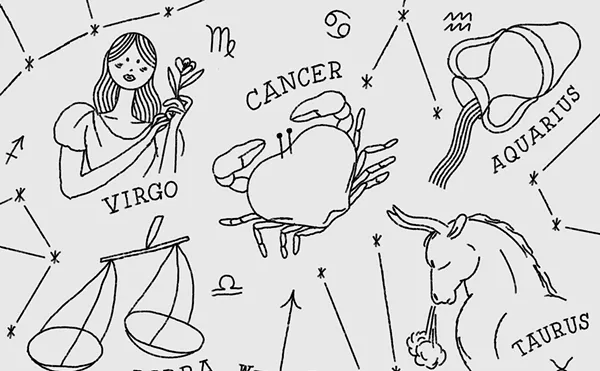A gauzy cloud of softly buzzing bees enfolds me as I stand in an abandoned lot in downtown Detroit. A tall man in a white suit like an astronaut's saunters through the tall weeds, carrying a device similar to a silver teapot with grass protruding from its spout. The "teapot" emits a trickle of smoke as the man, Patrick LaMourie, asks, "Did you know you were just riding in a car with an unsecured box of bees?"
"I had no idea!" I laugh, mildly alarmed, and LaMourie gives me a glowing grin. He's been keeping bees for only a year, but he's already obsessed with them, and an unsecured bee box — or the sting he's about to get on his upper thigh — doesn't deter him. Throughout the day I pepper him and his fellow beekeepers with questions as I'm given a tour of Detroit beehives, and I begin to realize how much there is to know about bees.
For one thing, while they're not exactly on the endangered list yet, honeybees have been in big trouble lately. As Elizabeth Kolbert points out in "Stung," an essay in the Aug. 6 issue of The New Yorker, beekeepers have "lost 70 percent of their colonies" during the past two years. Even the bee carcasses are missing — hives brim with pollen and larvae, but lack the adult bees needed to tend them. Previous decimating declines have been blamed on mites, viruses and general lack of genetic diversity, but this present plague (known as colony collapse disorder, or CCD) has researchers baffled.
In the East Bay Express last month, Susan Kuchinskas theorized CCD may be the result of exhaustion, as bees are being intensively farmed and transported to adequately pollinate the country's demanding crops of almonds, melons and cucumbers, among other popular foods. Climate change might also affect pollen nutrition levels, and bees' ability to survive the winter with enough energy left to build and maintain hives. And one group of researchers last week fingered a bee virus as the culprit.
Regardless of its roots, CCD has beekeepers fretting, and researchers predicting possible dire results. No bees pollinating our crops; no food for us. But while these developments are certainly distressing, beekeepers are retaliating with every trick in their arsenal, including more strictly managed bee care, and some intriguing places for hives.
That's why it's exciting to find out that metro Detroit community members from Highland Park to Royal Oak are tending hives. In one attempt to reclaim neglected land for productive use, volunteers have scattered 16 hives in strategic locations, all a casual walk from downtown. Listen carefully, and you may hear the nasal hum of worker bees ferrying pollen and nectar from the city's weeds, flowers and vegetables to their hives.
Cheerful, bearded Detroit native Rich Wieske has singlehandedly placed many of these hives in their new homes as part of his side-business, Green Toe Gardens. Six years ago, the chocolate truffles he made every year in large batches as holiday gifts for family and friends were getting out of hand. Wieske turned honey into mead as well, and was alarmed by the cost of raw honey. For such a hands-on manufacturer, vertical integration was the next logical step. Bees converted Wieske to their cause so quickly that he formed Green Toe Gardens to market his award-winning honey, which he sells at the Royal Oak Farmers' Market and Avalon Bakery. A grant from the sportswear company Patagonia enables him to lead community education programs, and to convert others to urban beekeeping. Though CCD has plagued some of his bigger business colleagues, Wieske says he hasn't noticed it among his own hives, perhaps because he isn't a large-scale beekeeper.
Every two weeks, Wieske takes a break from his day job at his film company to check on the hives and to show volunteers beekeeping techniques. His back yard-based hives recall those immigrants used to tend in the 1920s. Now, more than 80 years later, hives are slowly returning, tucked into spare lots and alleyways. City groups have quickly welcomed bees into their community gardens as well. Gardeners, Wieske says, speedily grasp the importance of the pollination a bee colony performs in any vegetable or flower patch. The plants require bees, butterflies and other pollinators in order to reproduce, so it just makes sense to link gardeners up with their own supply of bees.
Wieske explains that while the honey doesn't rake in major bucks for garden groups, it does build very strong community ties, and is easily sustainable. Most beekeepers keep honey and other bee products for personal use; producing honey for sale at a profit generally requires larger operations than most garden groups run. But the intangible benefits of beekeeping — pollination, personal enrichment and community building — seem to far outweigh any trepidation beekeepers have about working with these insects, or any desire for profit.
On this particular round of check-ups, I'm riding shotgun with Wieske to witness urban beekeeping in action. At our first stop, a community garden near Wayne State University, Wieske, barehanded, pulls up frame after frame for me to examine. Nearly every one bulges with a thick comb. Viscous, warm honey oozes down the sides of the boxes, smelling rich and heady. I nearly recoil when I taste the honey — it's so sweet it's almost painful, and I can feel it tingle in the back of my throat.
Bees create and store honey from the pollen and nectar they gather on fueling trips to neighborhood plants. I've seen jars of honeysuckle, red clover or other specific flavors of honey for sale in grocery stores, but I wonder aloud how these flavors are achieved with any degree of accuracy. Wieske says beekeepers need only position the hive near the desired plants, and wait for flowering. Once a specific plant crop is in bloom, bees will continue pollinating it until its season passes. The garden's bees are currently busy with blooming spearmint, and Wieske says the resulting honey will have a minty tang.
But it's not only about delicious honey. Advocates claim that the pollen bees harvest provides energy, rejuvenates cells and boosts immunity. "It's more valuable than gold," Wieske says. We're at another site in the city, where he encourages me to sample pollen, in the form of soft, grayish-yellow balls, like Dippin' Dots ice cream. Hesitantly, I smash a few of the balls and eat them. They're sweet and doughy.
Bees also use propolis, a resin they gather and manufacture from tree bark and buds. Scientists investigating propolis, as reported by the BBC and rakemag.com, get favorable results in tests pitting propolis against AIDS and cancer. The substance won't be cleared by the FDA or be mass-produced anytime soon, but fans gather it from hives by hand, or purchase it at farmers' markets, and swear by its curative and preventive properties. I chew a clump of it myself. It's like tasteless, long-lasting gum, and after chewing it for half an hour my mouth feels slightly numb.
Some bee fanciers practice apitherapy, deliberately allowing bees to sting them in an effort to ameliorate inflammatory diseases such as arthritis. And royal jelly, a clear, glutinous paste fed to growing larvae, is harvested and used in nutritional supplements and skin creams.
Given all these benefits, it's clear why people prize bees. In fact, a hive has recently been stolen from the first garden we visit. It's unusual, but not unheard of. Wieske and LaMourie shake their heads over the theft. For now, hives will be combined, but the loss will be felt, and also strikes a blow against the community garden's morale. A neighborhood woman wanders by and insists the theft must have occurred quite recently, because she and her son have been maintaining an informal surveillance of the hive.
"All of us got a stake in this," she says, gesturing to the remaining hive tucked among bright flowers and thick weeds. "We love 'em, because they keep out the riff-raff."
Such avid neighborhood loyalty regarding bees is apparently quite common. Betsy VanZandt lives in a block of Highland Park dating from 1911, and has recently adopted her own hive. Though her neighborhood couldn't be mistaken for the countryside, the area is full of garden patches, weeds and herbs, with apple trees and a wall of honeysuckle nearby. Already three other people on her street have expressed interest in fostering their own hives, which, VanZandt says, would create a thriving support community.
When, after taking a beekeeping class, VanZandt was offered the chance to host her own hive, she remembers being impressed yet scared. But the bees won her over with their tight communal approach to survival, and their subtle beauty, such as the way they fly in soft figure eights instead of circles or lines. "There's so much wisdom in those guys," she says.
Bees in metro Detroit do have to struggle hard for survival, facing mite infestation, possible theft or tampering, and Michigan's biting winters. A strong colony will typically form a dense ball inside the hive during cold temperatures, and will vibrate their muscles to stay warm. Hive temperatures often reach 100 degrees Fahrenheit, but hives will still occasionally succumb. Wieske tells me about one couple that hosted a hive that didn't make it. The couple was so heartbroken, Wieske says, they couldn't bring themselves to get a new colony.
Bees inspire strong feelings in general. At the third site we visit, a weedy lot in a suburban neighborhood, Wieske shows me hives going back six years. These are some of his original hives, and, though the original bees have long since died, their successors are hearty and enthusiastic. Wieske intends to keep them that way, by sifting powdered sugar over the hive to deter mites. The bees emerge, dusty-white and confused, but soon resume their pollination duties.
LaMourie wears a traditional white beekeeper's outfit, complete with mesh hood. Wieske dons and doffs his own hood throughout the day, depending on how closely he's working with the bees. I don't wear any protective gear at all, and, though I'm nervous, I can't help but notice the bees' single-minded commitment to their hives. They don't bother me — only one ever "buzzes" me, hovering a moment near my ear as an investigatory warning before flying away — and I'm amazed by the bees' relative tranquility and sense of purpose as I stand among clouds of them. Acrid smoke from LaMourie's smoker makes my eyes water, and I'm getting a sunburn, but I think I'm starting to understand the beekeepers' fascination with their charges.
Bees have certainly captivated people throughout the ages. Wieske happily references texts by Virgil and Aristotle, and says beekeeping goes back to the ancient Egyptians, who sometimes even used propolis in embalming rituals. He's not content to stop with historic knowledge though. He's currently teaching himself how to husband queen bees, and how to use beeswax for candlemaking.
He also continues to visit beekeepers around the world, and to advise other cities interested in beekeeping. Chicago, for example, runs a thriving program, and even has hives on the roof of City Hall. Wieske hopes for similar results in Detroit, and is always on the lookout for new hive hosts.
VanZandt certainly hasn't regretted her own role in hosting. "So much doom and gloom seems to permeate our daily lives, and this is something that seems to be a little spark, bringing sweetness to everyone," she says. She's one of dozens wishing Detroit's urban bees a sweet future.
Cyan James writes about science and literature for Metro Times. Send comments to [email protected]





